Ready to bake the softest dinner rolls? Our Easy Yeast Rolls Recipe is perfect for everyone. Simple steps, delicious results – let's get baking!
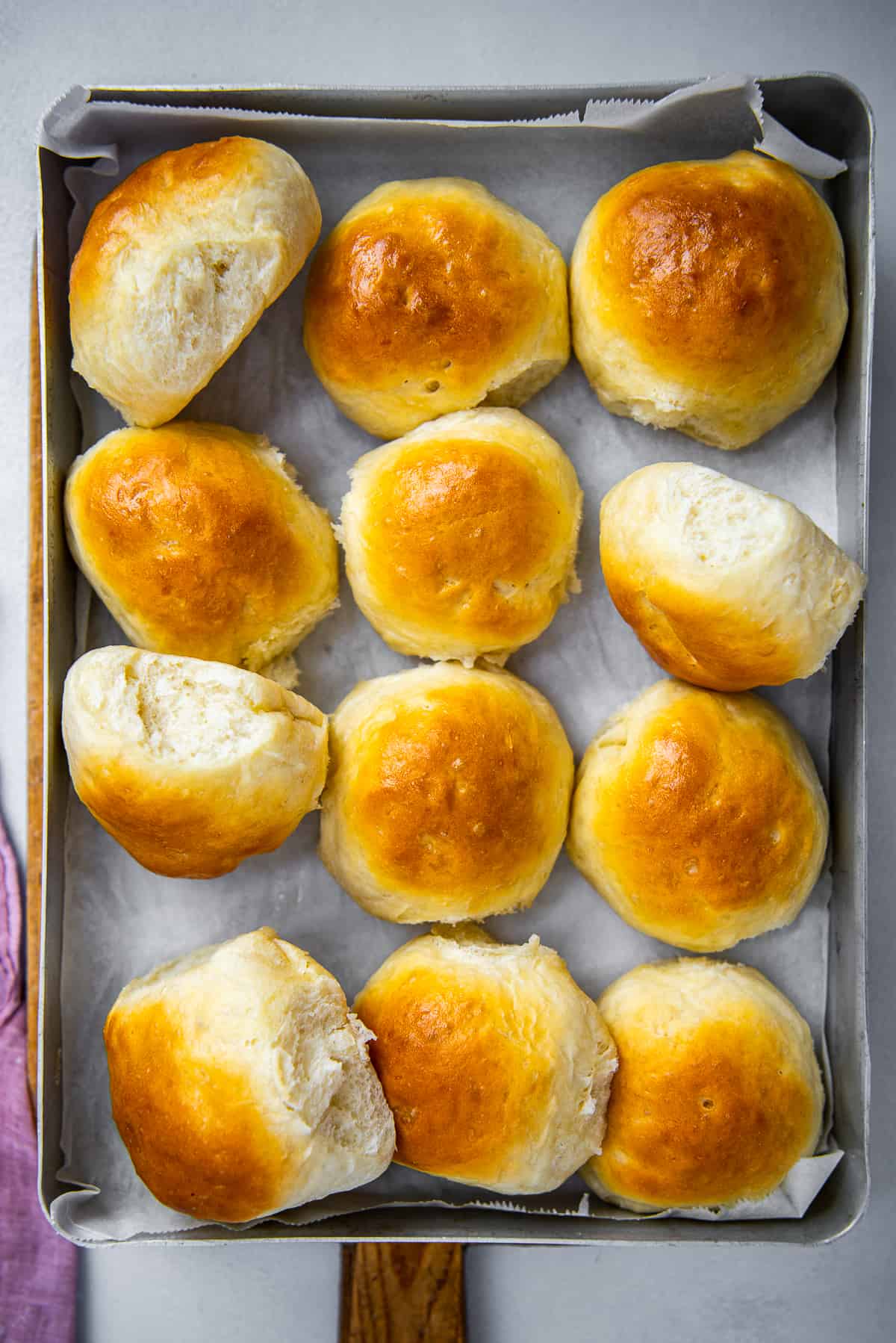
These dinner rolls are made with yeast and they are so soft and fluffy! Believe it or not, it is so easy to make them. All you need is a few basic ingredients. With this well proven classic recipe, they ALWAYS turn out great!
We promise you will feel like a pro after making our easy recipe for yeast rolls. This is one of our best bread recipes. But if you are looking for a quick roll recipe, check out our No Yeast Dinner Rolls Recipe.
These homemade dinner rolls are sooo handy. You can have them with soups or as a side dish with almost any meal. We like to bake them especially when we are having some guests over for dinner because one batch can definitely feed a crowd.
Jump to:
- Is it Easy To Make Dinner Rolls with Yeast?
- About The Ingredients
- Choosing the Right Yeast
- Choosing The Right Flour
- How To Make It
- Our Success Tips
- Why is a Second Rise Essential?
- Proofing the Dough Properly
- Prevent Your Rolls from Becoming Tough
- Storing & Reheating
- Serving Suggestions
- Variations
- Frequently Asked Questions
- More Bread Recipes
- Recommended
- 📖 Recipe
Is it Easy To Make Dinner Rolls with Yeast?
Absolutely! Making yeast dinner rolls at home is not only easy, but it's also quite enjoyable. Believe it or not, when we first tried making these rolls years ago, we nailed it on our first attempt!
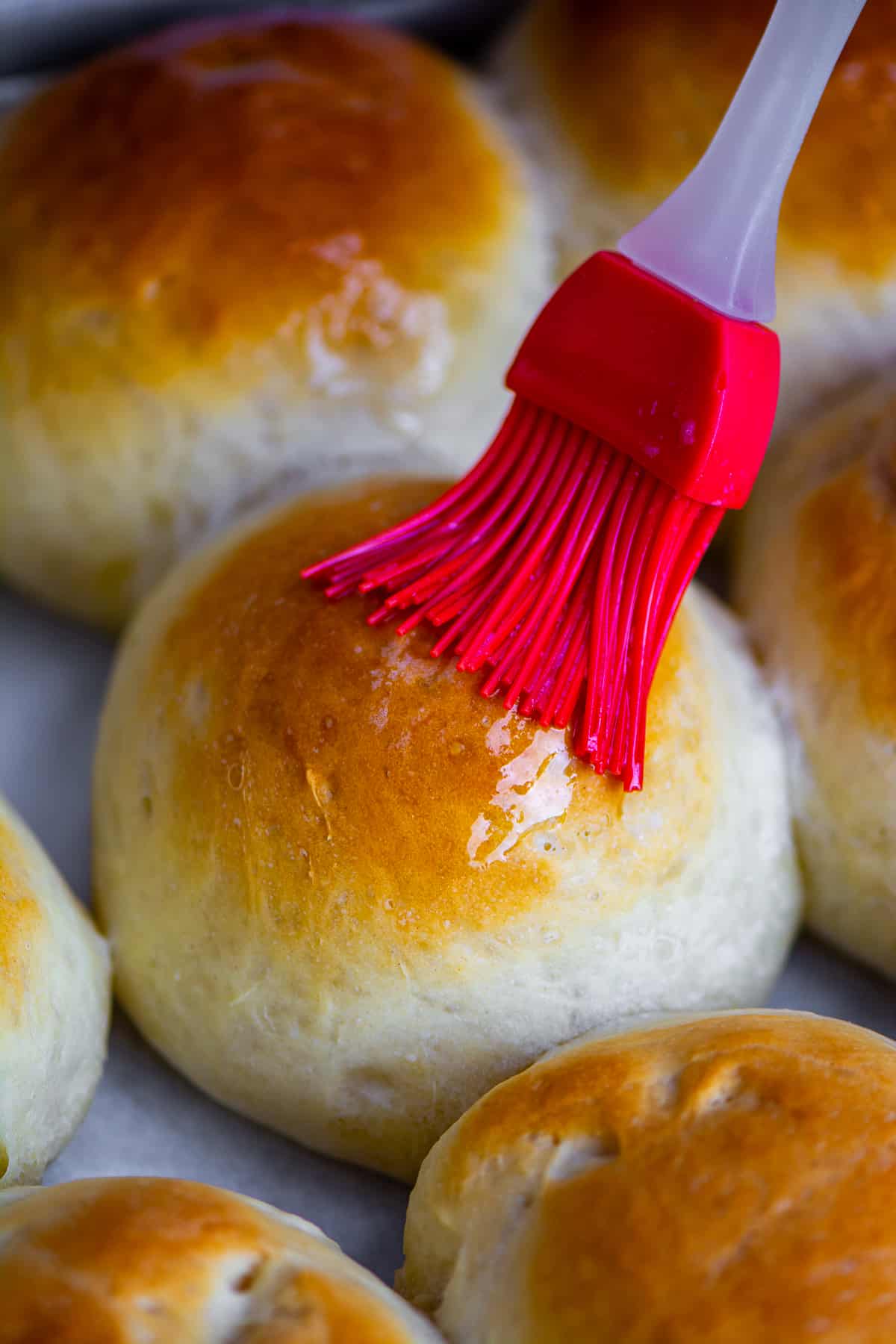
This shows how approachable and foolproof the recipe is. It’s perfect for beginners. Here is why:
- It is made with simple ingredients.
- No special equipment needed.
- The process involves straightforward steps - mixing the ingredients, letting the dough rise, shaping the rolls, letting them rise again, and then baking them.
About The Ingredients
Our easy yeast rolls recipe is for beginners and calls for simple ingredients that come together to create soft and fluffy result.
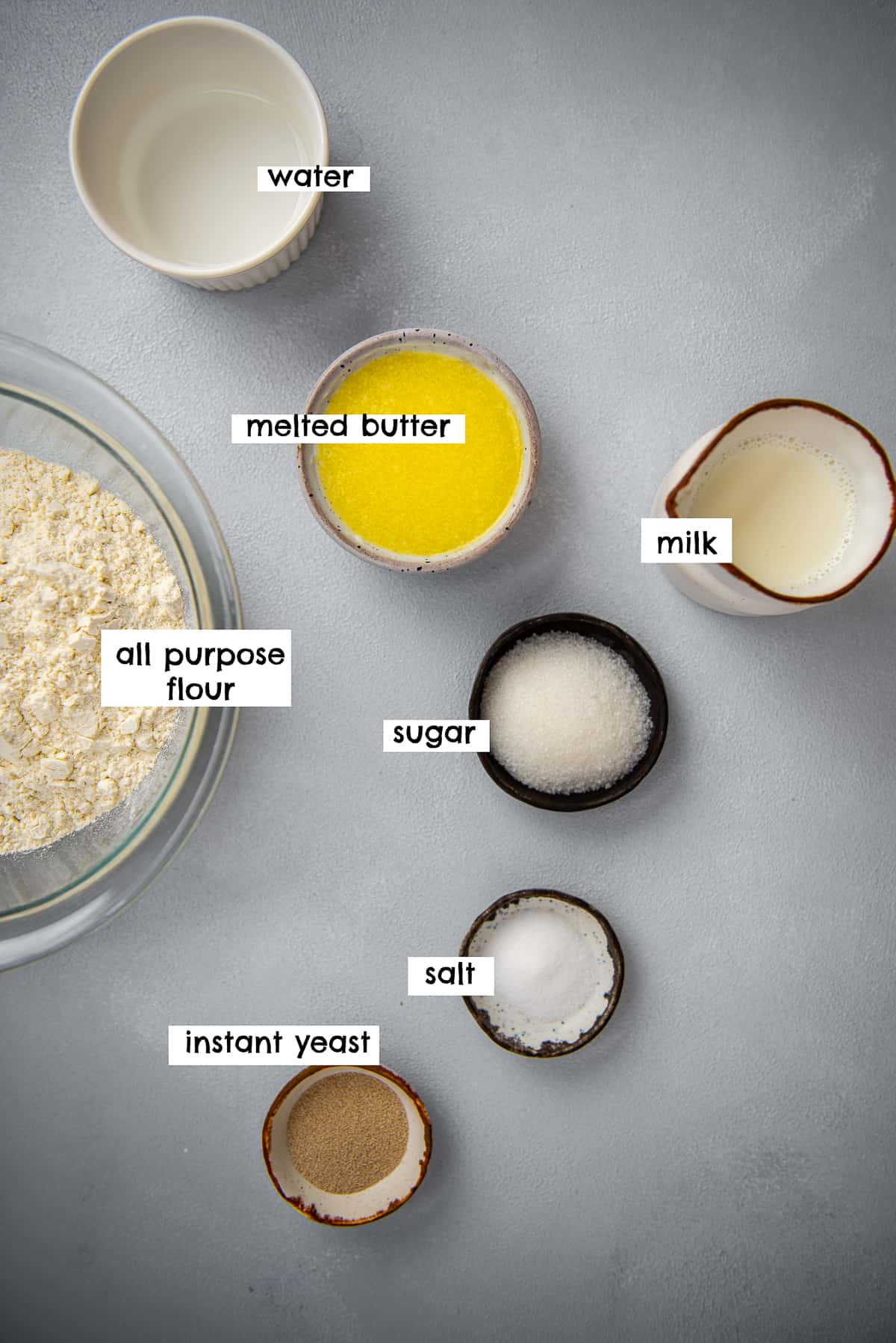
- Warm Water: Activates the yeast, helping it to start the fermentation process. The temperature (110-115˚F) is key. It should be warm but not too hot, as extremely hot water can kill the yeast.
- Instant Yeast: Also known as rapid-rise yeast. A reliable and convenient choice for bread making. It works faster than active dry yeast. This yeast helps the dough rise and contributes to the fluffy texture of the rolls.
- Sugar: We use just 1 tablespoon of sugar to feed the yeast, which aids in the fermentation and rising process. You can add extra 3 tablespoons of sugar in the flour and salt mixture if you want your dinner rolls to be sweeter.
- All-Purpose Flour: It’s versatile and easily accessible, making it ideal for this recipe. The gluten in the flour helps to trap the gases released by the yeast, leading to light and airy rolls.
- Salt: Essential for flavor.
- Warm Milk: Helps to activate the yeast. It also adds richness and tenderness to the dough, contributing to the soft texture of the rolls.
- Melted Butter: Adds flavor, richness, and moisture to the rolls. It also contributes to the soft and tender crumb structure, making the rolls melt-in-your-mouth delicious. You can also use olive oil instead of butter to make the rolls lighter. But we all know that buttery rolls taste better.
Note: Unlike several other recipes for homemade yeast rolls around the web, this recipe doesn’t require eggs. There is really no need for them. Yeast, butter and milk work perfectly together for the texture. You end up with super soft, fluffy and buttery rolls thanks to them.
Choosing the Right Yeast
When baking dinner rolls, the type of yeast you use can significantly affect the outcome. There are two main types of yeast commonly used in baking: Active Dry Yeast and Instant Yeast. Here's a breakdown to help you choose the right one:
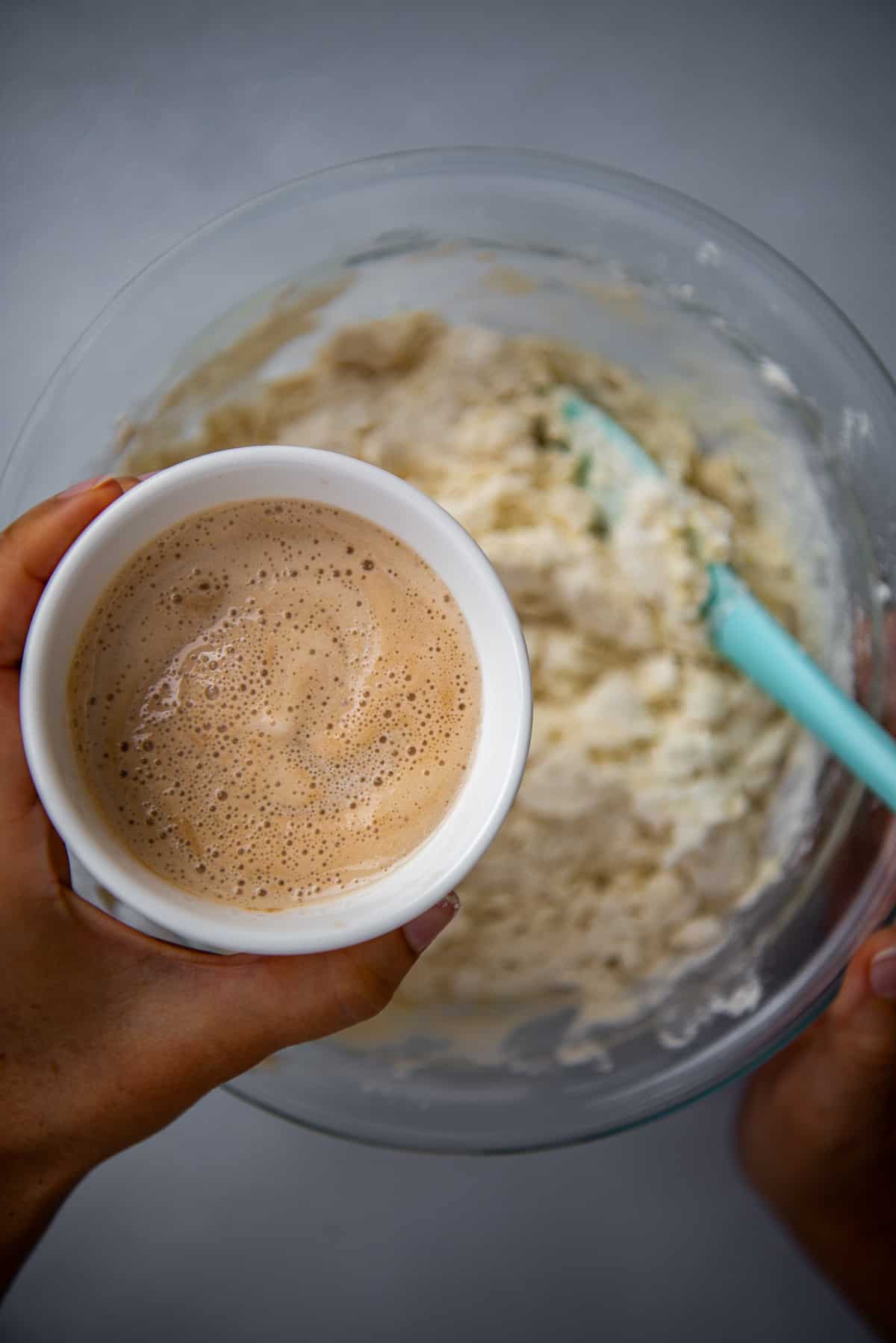
Active Dry Yeast:
- Activation Required:Active dry yeast needs to be dissolved in warm water (about 110°F or 45°C) before being added to the other ingredients. This 'proofing' process ensures that the yeast is alive and active.
- Slightly Slower Rising: It may take slightly longer for the dough to rise when using active dry yeast compared to instant yeast.
Instant Yeast (also known as Rapid-Rise Yeast or Quick-Rise Yeast):
- No Activation Needed:Instant yeast can be mixed directly with the dry ingredients without needing to be dissolved in water first. This makes the baking process a bit quicker and simpler. That being said, in this recipe, we prefer dissolving it in water before mixing it with the remaining ingredients.
- Faster Rising Times: This type of yeast is more finely ground and tends to speed up the rising process.
- Convenient and Reliable: Ideal for those who bake frequently or are looking for a more consistent, fail-proof result.
Which One to Use?
Either type can be used. That being said, instant yeast is often preferred when making easy homemade dinner rolls for its convenience and faster rising time. However, active dry yeast can be just as effective, especially if you’re familiar with proofing yeast.
If substituting one for the other, use the same amount if the recipe calls for one packet (¼ ounce) of yeast. For bulk measurements, use slightly less instant yeast than active dry yeast.
Choosing The Right Flour
When it comes to baking yeast dinner rolls, the type of flour you use can significantly influence the texture and quality of the rolls.
All-Purpose Flour: This is the most commonly used flour in yeast roll recipes. It has a moderate protein content, typically around 9-12%, which is ideal for achieving a balance between tenderness and structure in the rolls. The gluten content in all-purpose flour is sufficient to provide the necessary elasticity and rise without making the rolls too chewy.
Bread Flour: It has a higher protein content (about 12-14%), which means more gluten development. If you want rolls with a slightly chewier texture and a bit more structure, bread flour is a great choice.
Whole Wheat Flour: This flour has a higher fiber content and a stronger flavor. It can make the dinner rolls denser and less fluffy, so it's often used in combination with all-purpose flour.
Avoid Self-Rising Flour: Not recommended for this yeast dinner roll recipe as it already contains baking powder and salt. Using this type of flour can disrupt the delicate balance of ingredients required for the yeast to work effectively.
How To Make It
Be sure to see the recipe card below for the full ingredients list & instructions!
This easy yeast roll recipe requires a few simple steps to give you a delicious result every time.
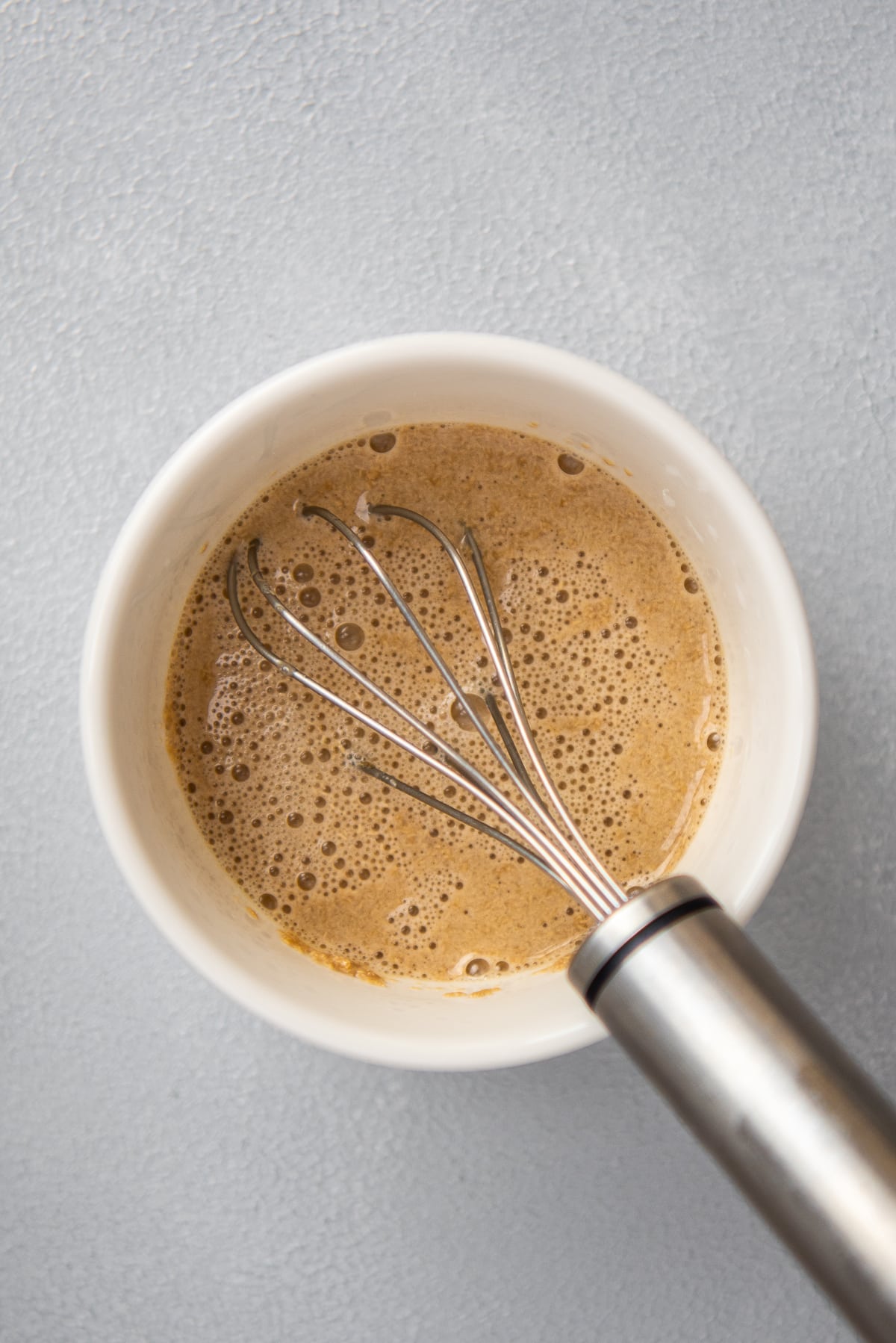
- Prepare the Yeast Mixture: In a small bowl, whisk together warm water, instant yeast, and sugar. Let this mixture sit for about 5 minutes. While instant yeast doesn’t necessarily need proofing, we think it gives even better results when you proof it first.
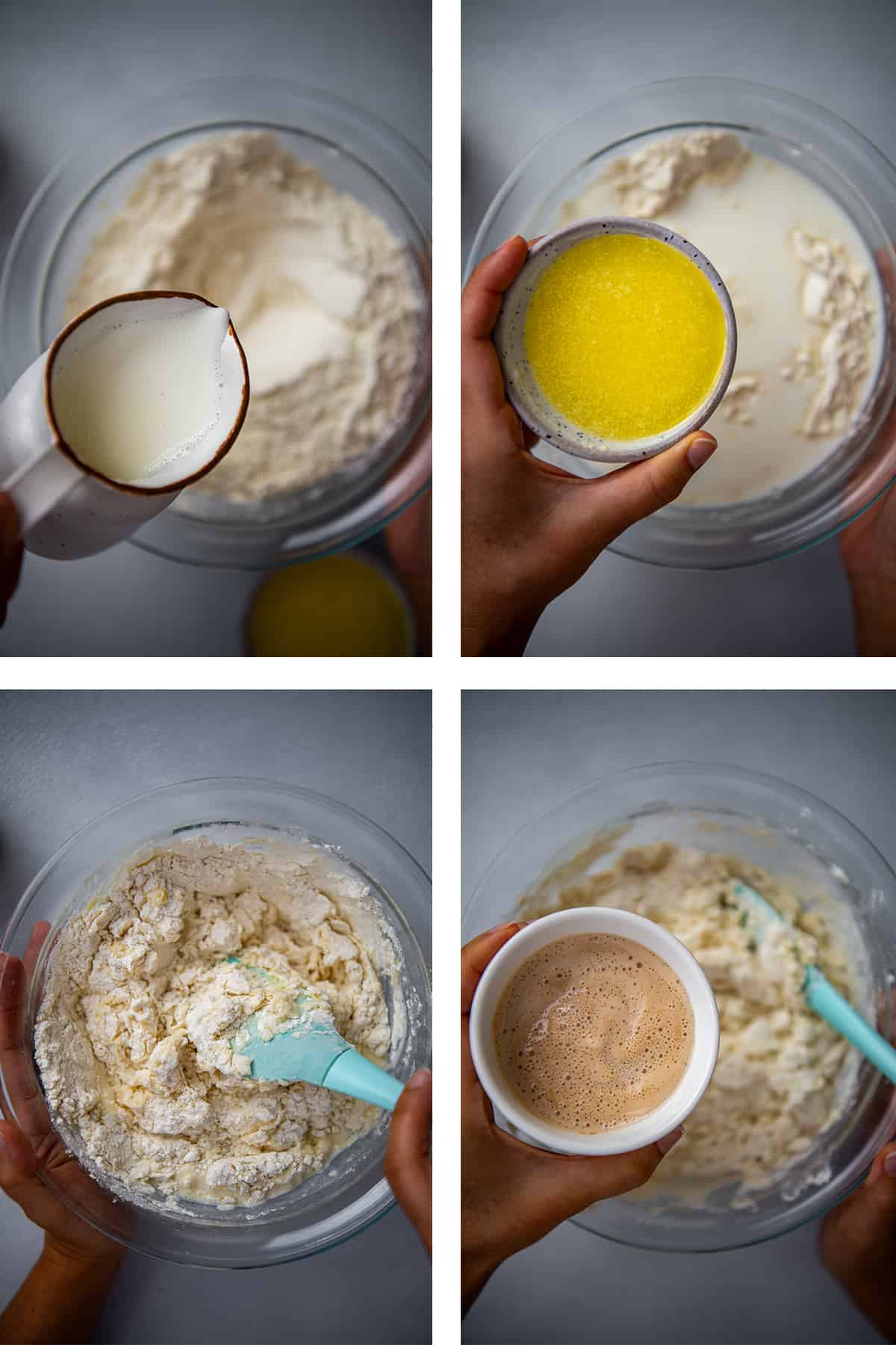
- Mix Dry and Wet Ingredients: In a large bowl, combine all-purpose flour and salt. Add in the warm milk and melted butter to this flour mixture. Pour the proofed yeast mixture into the bowl with the flour.
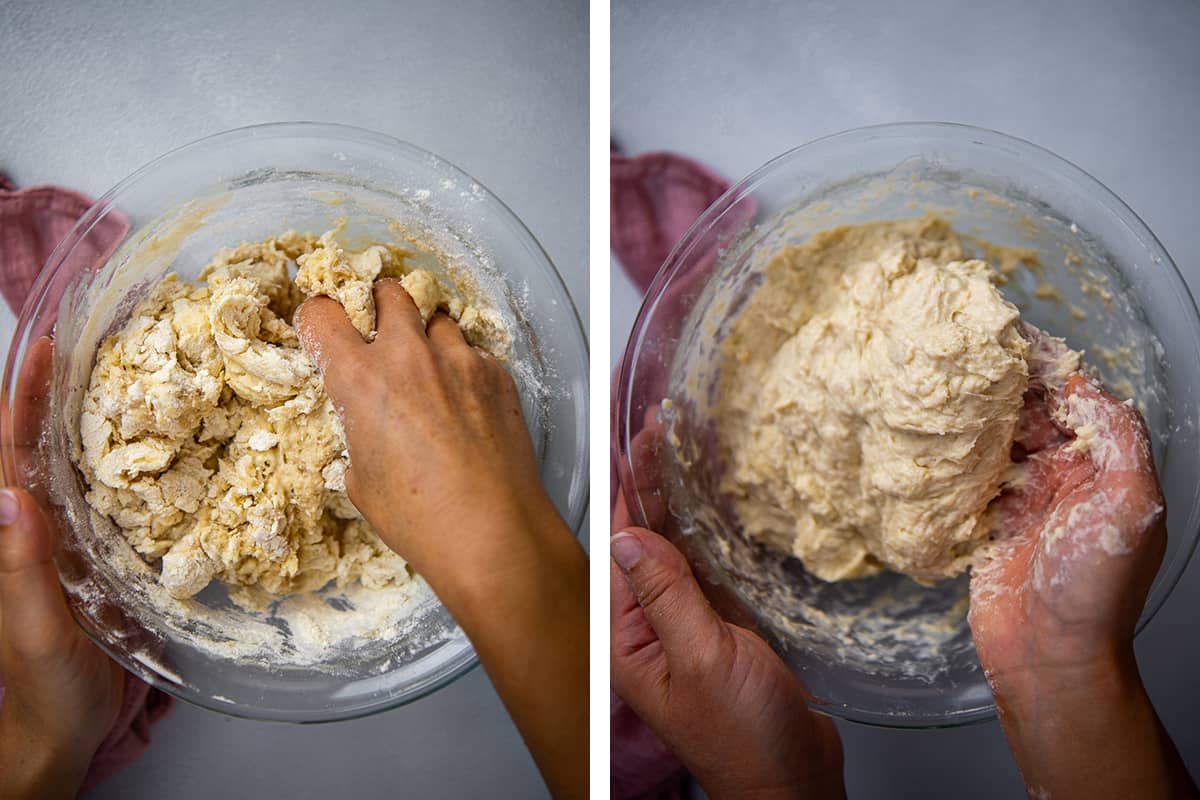
- Knead the Dough: Using your hands, combine all the ingredients in the bowl. Knead the mixture right in the bowl. If the dough sticks to your fingers, wet them slightly with water. Continue kneading (just for 3-4 minutes) until the dough becomes smooth yet a bit sticky.
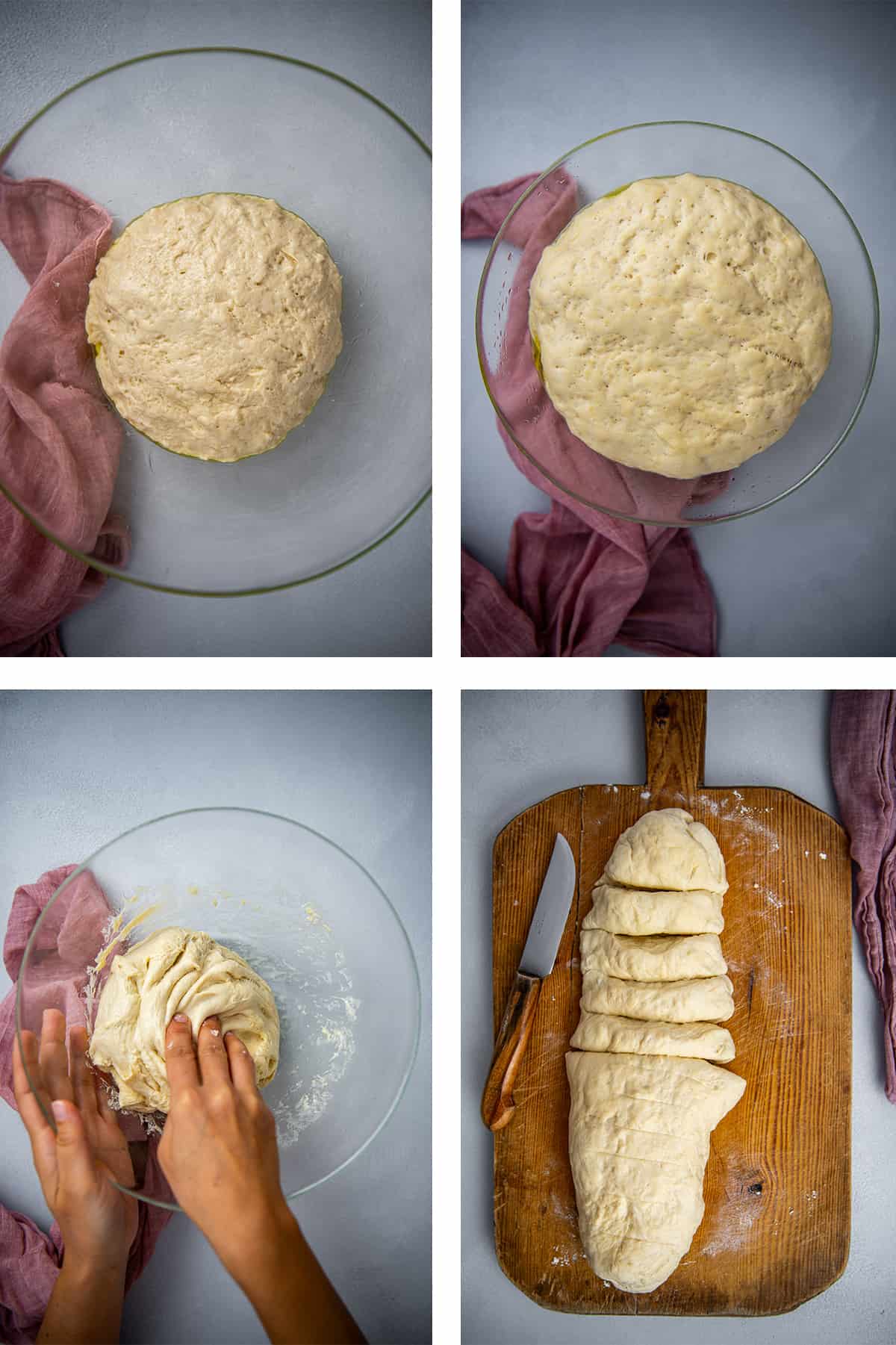
- Let the Dough Rise: Transfer the dough to a lightly greased large bowl, making sure to grease all the sides. Cover the bowl with a clean kitchen towel or plastic wrap. Allow the dough to sit at room temperature for about 1 hour, or until it doubles in size.
- Punch Down and Shape the Dough: Once the dough has risen, punch it down gently to release air. Transfer the dough onto a lightly floured surface and shape it into a log. Cut the log into 12 equal pieces.
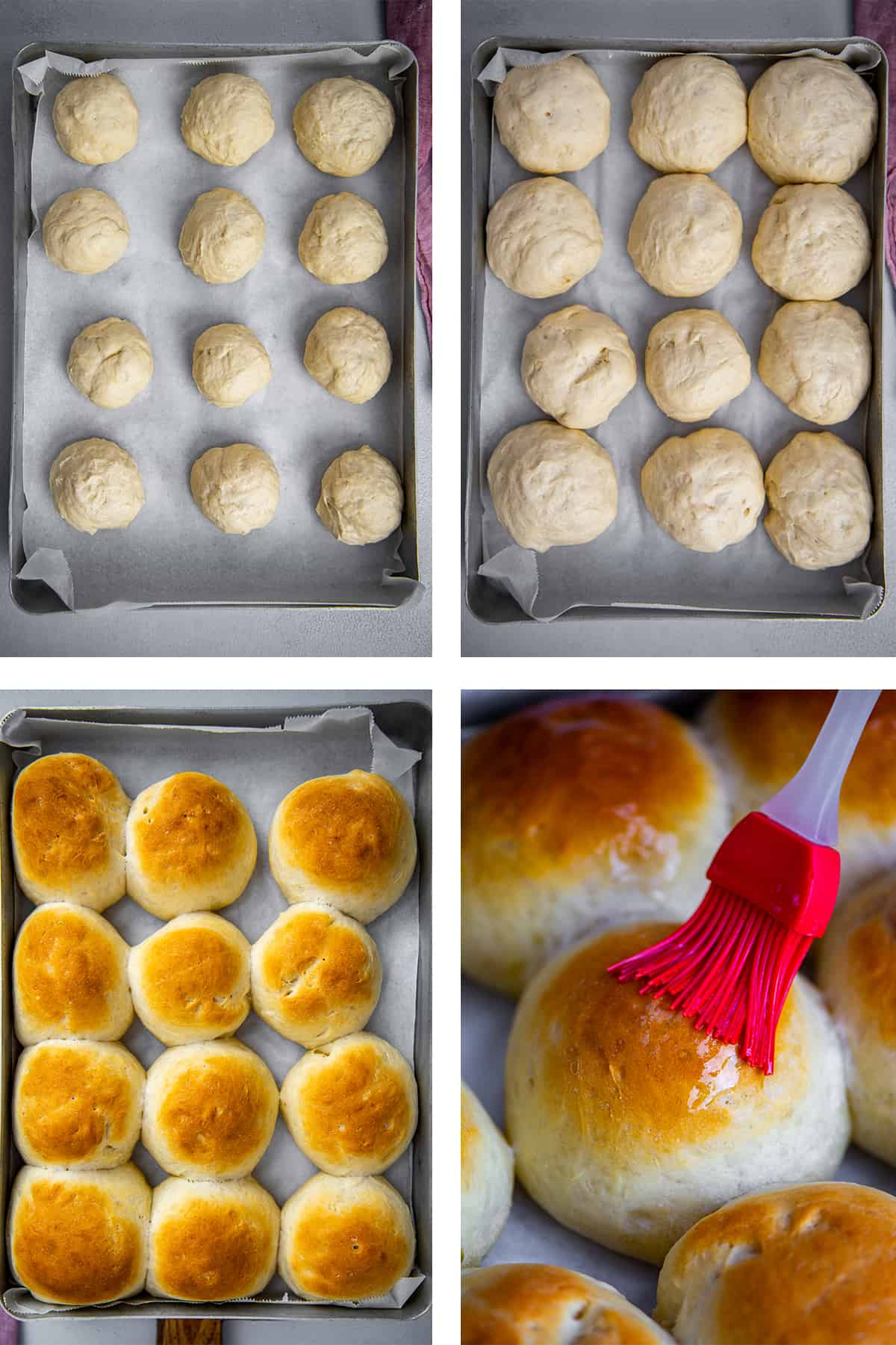
- Second Rise: Shape each piece into a ball and place them in a 9 x 13 inch baking pan lined with parchment paper. Cover the pan with a kitchen towel or plastic wrap. Let the rolls rise for at least 40 minutes.
- Bake the Rolls: Preheat your oven to 375°F (190°C). Bake the rolls for 15-20 minutes, or until they turn golden brown.
- Finishing Touches: Remove the rolls from the oven and brush each with melted butter. Allow them to cool for about 10 minutes before serving.
- Storing Leftover Rolls: Keep any leftover rolls tightly covered at room temperature for 2-3 days, or in the refrigerator for up to a week.
Making the Dough in a Stand Mixer
For those who prefer using a stand mixer, making the dough for these yeast dinner rolls is even more effortless. Here's how to do it:
- Combine Ingredients in Mixer: Place the flour and salt in the bowl of your stand mixer. Add the warm milk and melted butter to the flour mixture. Pour the proofed yeast mixture over these ingredients.
- Mixing the Dough: Attach the dough hook or paddle attachment to your stand mixer. Set the mixer to a low speed and beat the mixture until the dough starts to come together. You'll notice the dough beginning to pull away from the sides of the bowl.
- Knead in the Mixer: Continue beating the dough for 1-2 minutes at the same low speed. The goal is to achieve a smooth and slightly sticky dough.
Our Success Tips
When baking rolls with yeast, it's important to pay attention to a few key details:
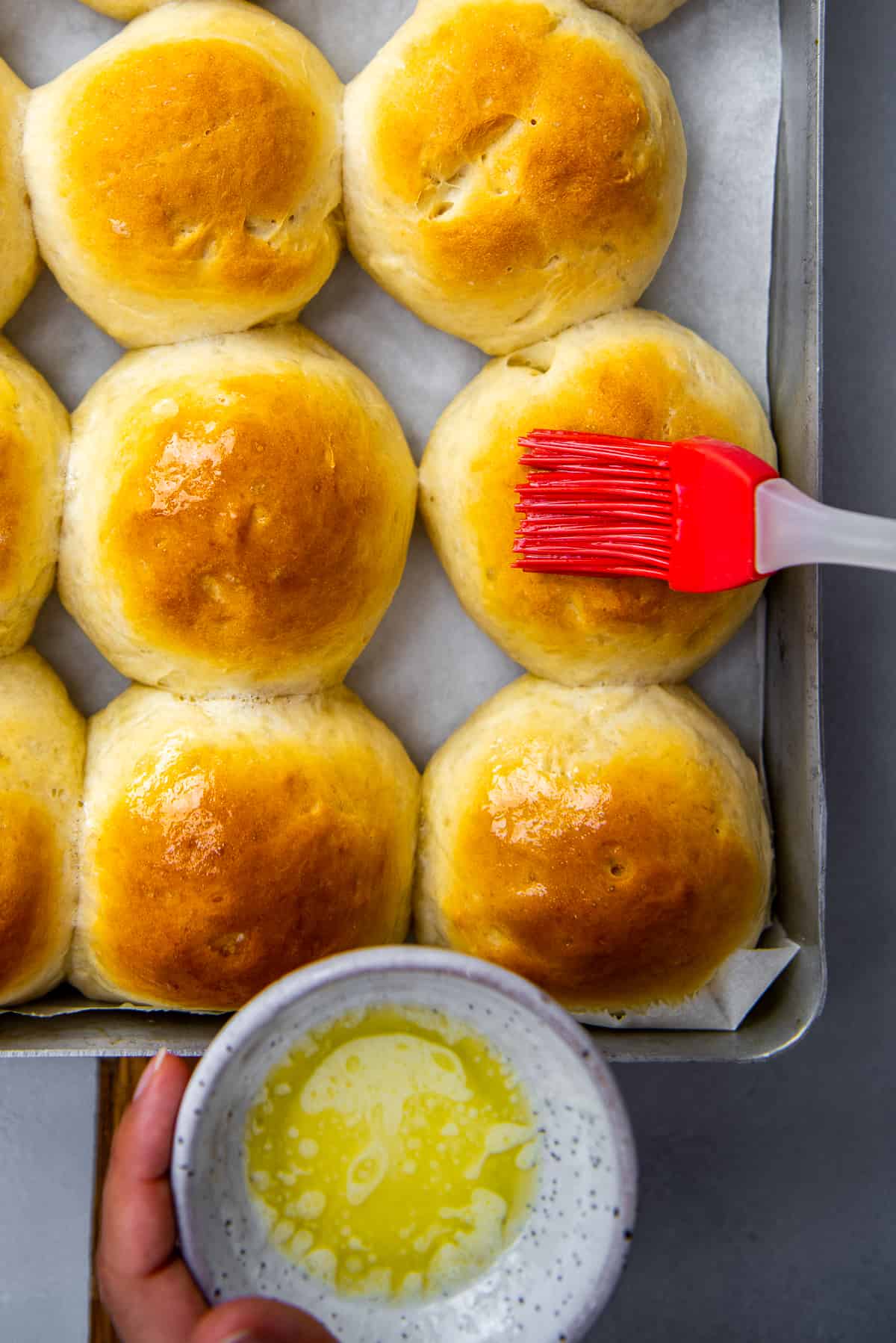
- Warm Ingredients: Make sure all ingredients, like milk and water, are warm or at room temperature. Yeast works best in a warm environment.
- Dough Consistency: The dough shouldn't be too hard or too soft. Aim for a balance to ensure it rises properly.
- Allow Enough Rising Time: Give the dough enough time to rise. This is crucial for light, fluffy rolls.
- Right Environment for Rising: Place the dough in a warm, draft-free spot. Avoid cool or cold areas, like a balcony, and keep windows closed in cold weather. If it's too cold, the dough won't rise well.
- Punch Down After First Rise: After the dough has risen once, punch it down. This releases any gas from the yeast and relaxes the gluten, improving the texture of your rolls.
Why is a Second Rise Essential?
The second rise, or proofing, is important when you want to make the best dinner rolls with yeast. Here are the reasons:
- Improves Flavor and Texture: The yeast continues to work, enhancing the bread's flavor and creating a lighter, fluffier texture.
- Increases Volume and Structure: This rise allows the dough to expand, contributing to the rolls' size and soft internal structure.
- Ensures Even Baking: A good second rise leads to uniform baking, preventing dense or heavy rolls.
- Keeps the shape: Well-proofed dough is less likely to deflate and maintains its shape better when baked.
Don't skip this step! Otherwise, you will get dense and unevenly baked dinner rolls.
Proofing the Dough Properly
Proofing, or letting the dough rise, is a key step in bread making, especially with yeast doughs like for dinner rolls. Here’s how to proof your dough well:
- Warm Environment: The dough needs a warm place to rise properly, ideally around 75-85°F (24-29°C). If your kitchen isn't warm enough, you can create a warm spot in your oven. Turn it on to the lowest setting for a few minutes, then turn it off and place the dough inside.
- Cover the Dough: Place the dough in a greased bowl and cover it with a damp kitchen towel or plastic wrap. This keeps the moisture in and prevents the dough's surface from drying out.
- Timing Is Key: Let the dough rise until it doubles in size. This typically takes about 1 hour, but it can vary. Focus on the dough's size rather than the clock.
- Stable Conditions: Keep the dough away from drafts and maintain a consistent temperature. Fluctuations can interfere with the rising process.
- Test for Readiness: Gently press the dough with your finger. If the indentation stays, the dough has risen enough and is ready for the next step.
Prevent Your Rolls from Becoming Tough
Not to end up with hard and heavy yeast rolls, here are some key tips to follow:
- Proper Kneading: Knead the dough just enough to develop the gluten, which gives the rolls their structure. Over-kneading can result in tough rolls. The dough should be smooth and slightly tacky, but not overly stiff.
- Correct Flour Type: Use all-purpose flour for the basic yeast roll recipe. It has a moderate protein content, ideal for soft and tender rolls. Bread flour, with a higher protein content, can make the rolls chewier and tougher.
- Avoid Overcooking: Bake the rolls for the recommended time and at the right temperature. Over-baking can dry them out and make them hard. Keep an eye on them and remove them from the oven once they’re golden brown.
- Fresh Yeast: Use fresh yeast and make sure it’s properly activated. This is crucial for a good rise, which contributes to a soft texture.
- Adequate Rising Time: Allow enough time for the dough to rise until it doubles in size. A good rise is essential for creating light and fluffy rolls.
- Gentle Handling: Be gentle when shaping the rolls. Too much handling or pressing can deflate the dough and affect the final texture.
- Proper Storage: Store leftover rolls in an airtight container to keep them soft. Reheat them covered, so they don’t dry out.
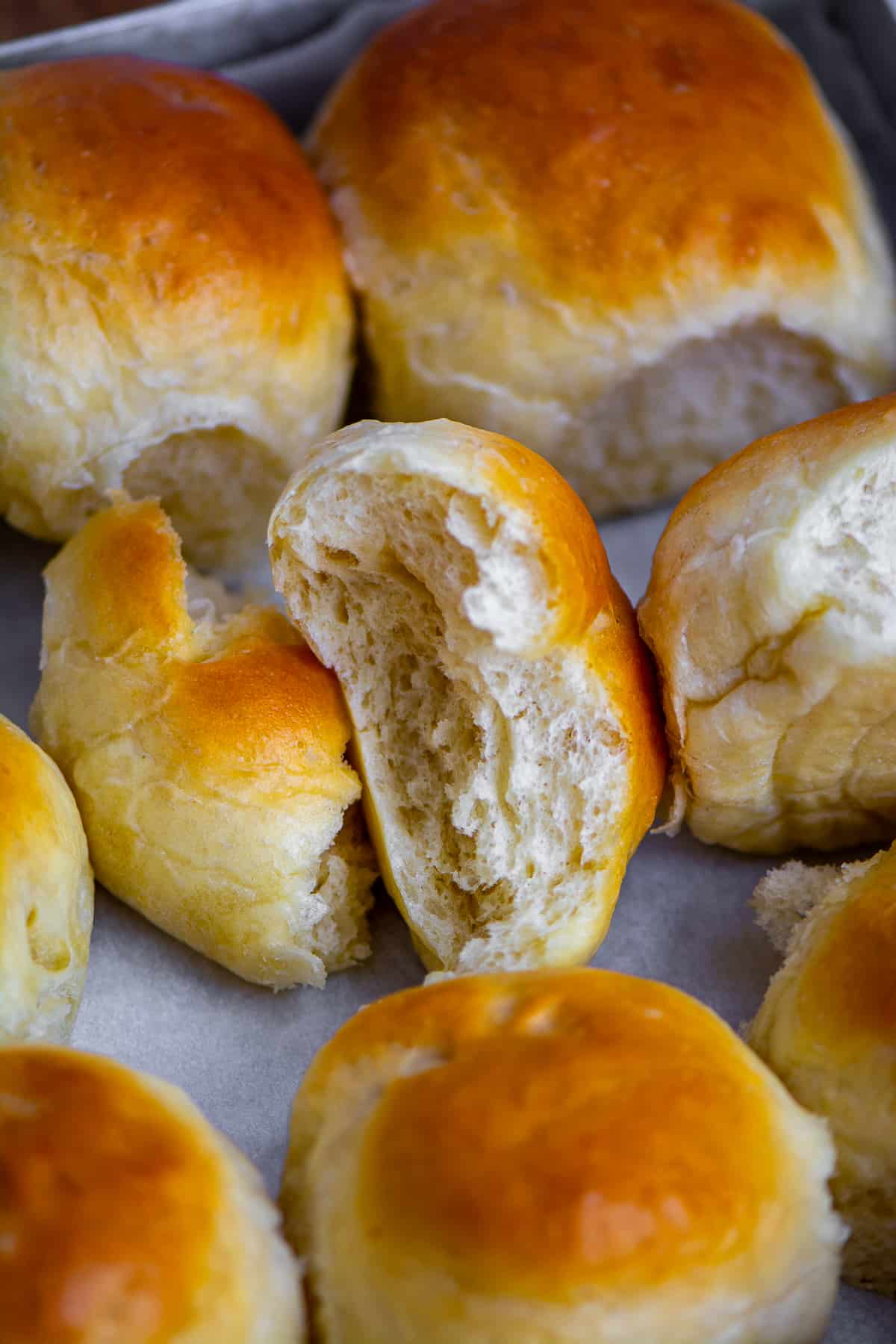
Storing & Reheating
To keep your homemade dinner rolls fresh and delicious, proper storage and reheating methods are essential. Here’s how to do it:
Storing:
- Cool Completely: Allow the rolls to cool completely at room temperature before storing. Storing them while still warm can lead to moisture buildup and sogginess.
- Airtight Container or Plastic Bag: Place the cooled rolls in an airtight container or a resealable plastic bag. This helps to maintain their moisture and freshness.
- Room Temperature Storage: For short-term storage (2-3 days), keep them at room temperature. Avoid direct sunlight and keep them in a cool, dry place.
- Refrigerating: If you need to store them for up to a week, place them in the refrigerator. This slows down the staling process.
- Freezing for Long-Term Storage: For longer storage, wrap the rolls individually in plastic wrap and then place them in a freezer-safe bag or container. They can be stored in the freezer for up to 3 months.
Reheating:
- Thawing: If frozen, let the rolls thaw at room temperature before reheating.
- Reheating: Preheat your oven to 300°F (150°C). Place the rolls on a baking sheet and cover them with foil to prevent them from drying out. Heat for about 5-8 minutes or until they are warm throughout.
Can I Freeze Them Before Baking?
Yes, you can freeze yeast rolls before baking. After shaping the rolls, place them on a baking sheet and freeze until solid. Then, transfer them to a freezer-safe bag or container. When you're ready to bake, thaw them at room temperature, let them complete the second rise, and then bake as directed.
Serving Suggestions
Homemade dinner rolls are a great addition to any meal. Here are some serving suggestions to make the most out of these soft, fluffy bread buns:

- Classic Butter Spread: Serve the rolls warm with a side of butter. The simple combination of fresh bread and soft butter is always a crowd-pleaser. They are great with honey butter as well.
- With Soups and Stews: They are the best when served with soups like Roasted Garlic Tomato Soup, Carrot Tomato Soup, Tomato Rice Soup or Unstuffed Cabbage Soup. Use your fresh bread rolls to soak up the delicious flavors of hearty dishes like Meatball Stew.
- Slider Sandwiches: Transform the rolls into mini sandwich sliders. They are ideal for small bites filled with pulled pork, chicken salad, Turkish döner, or your choice of deli meats and cheeses like feta cheese or grilled halloumi.
- Breakfast or Brunch: Serve them at breakfast or brunch with jams (like our orange jam), jellies, or honey. Pair them with eggs, bacon, or sausage for a complete meal.
- Dinner Side Dish: Accompany a main course like Unstuffed Cabbage Casserole, Turkish Beef Stew, or Baked Whole Sea Bass with these rolls.
- Holiday Meals: These buttery rolls are a must-have for holiday dinners like Rice Stuffed Chicken. They pair wonderfully with traditional dishes for Thanksgiving, Christmas, or Easter.
Variations
Experimenting with different variations can add exciting flavors and textures to your yeast dinner rolls. Here are some creative ideas to try:
- Herb Rolls: Add herbs like rosemary, thyme, parsley or dill to the dough for a fragrant twist. This works great with savory meals.
- Cheese Rolls: Incorporate shredded cheese, such as cheddar or mozzarella, into the dough or sprinkle it on top before baking for cheesy, gooey rolls.
- Seed-Topped Rolls: Before baking, brush the rolls with an egg wash and sprinkle with seeds like sesame, poppy, or sunflower seeds for added crunch and nutrition.
- Stuffed Rolls: Similar to Turkish pogaca, before shaping, fill portions of the dough with fillings like cheese, or Nutella for a sweet version.

Frequently Asked Questions
Dinner rolls should be stored in plastic bags or wrapped in foil. Also, it is important that they should be stored at room temperature, not in the fridge because they will become dry in the fridge.
There might be a few reasons for this. Did you knead your dough long enough? Or did you let it rise long enough? These are important.
Your dough might have too much salt in it or the content of the flour you use might have little protein. Or maybe you left your dough to rise in a place that was too hot and it killed your yeast.
Again there might be several reasons behind it. Here are some important points to be careful about:
Make sure your yeast is good. It should be stored in refrigerator and it should not be too old.
The water you use to make your dough should not be too hot. Too hot water kills the yeast. Too cold water is not good for the yeast either.
Make sure you give the dough enough time to rise. It should rise to a double size.
Kneading for about 10 minutes is mostly enough. At the end of this duration, your dough should hold its shape. get smooth and slightly sticky. Plus, you can make a poke test. Poke that ball of of dough with your finger firmly. If it fills back quickly, it is well kneaded. If it doesn’t fill back, keep kneading.+
Dough is loose and tears easily when it is under kneaded. Keep kneading until it holds the shape and doesn’t tear easily.
If dough is dense and tough, it is over kneaded. This dough will not easily rise, so keep the rising time a bit longer.
Yes! It would be way easier for you. Use a dough hook attachment and make the dough in your stand mixer.
More Bread Recipes
Our cheese stuffed Turkish pogaca are usually on high demand at gatherings. But when we want something plain but as good, we go for these yeast dinner rolls. And below is a list of bread recipes that we often make.
- Dinner Rolls without Yeast
- Ramazan Pidesi (Turkish Pide Bread)
- Cornmeal Bread without Flour
- Bazlama Bread
- No Yeast Bread
- Lavash Bread
Recommended
As always: If you make this recipe, let us know what you think by rating it and leaving a comment below. And post a pic on Instagram too—tag @give_recipe so we can see!
Sign up for the FREE GiveRecipe Newsletter to get the new recipes into your inbox! And stay in touch with us on Facebook, Pinterest, YouTube and Instagram for all the latest updates.
📖 Recipe
Easy Yeast Rolls Recipe
This Easy Yeast Dinner Rolls recipe will show you how to make soft, fluffy, and buttery rolls perfectly. They are simple to make and impossible to resist. Ideal for both special occasions and everyday meals, they're sure to become a family favorite.
- Prep Time: 1 hour 50 minutes
- Cook Time: 20 minutes
- Total Time: 2 hours 10 minutes
- Yield: 12 1x
- Category: Bread
- Method: Baking
- Cuisine: American
Ingredients
- ¼ cup warm water
- 2 and ¼ teaspoon instant yeast
- 1 tablespoon sugar
- 3 and ½ cups all purpose flour
- 1 teaspoon salt
- 1 and ¼ cup warm milk
- ¼ cup melted butter
Optional Topping:
- 1 tablespoon melted butter
Instructions
- To make the yeast mixture, whisk together warm water, instant yeast and sugar in a small bowl. Wait for 5 minutes. Although this step is not necessary for this type of yeast and you can just whisk it together with flour, we find it works even better when mixed together with warm water first.
- In a large bowl, combine flour, salt, milk and butter. Pour the proofed yeast in the large mixture.
- Combine everything using your hands. Knead it with your hands right in the bowl. Wet your fingers with a little water occasionally so that the dough doesn't stick. Keep kneading until you have a smooth but slightly sticky dough.
- Transfer the dough into a large bowl that is slightly greased (not just the bottom, all the sides inside). Cover with a clean kitchen towel or plastic wrap and let it sit at room temperature for 1 hour to rise.
- When the dough doubles in size, punch it down to release the air.
- Transfer the dough on the slightly floured counter and shape it into a log. Cut it into 12 pieces.
- Preheat oven to 375 F / 190 C.
- Roll each into a ball and place them in a 9 x 13 inch (23 x 33 cm) baking pan that is lined with parchment paper. Cover them with a clean kitchen towel or plastic wrap and let them rise, at least for 40 minutes.
- Bake the rolls for 15-20 minutes or until golden.
- Remove from the oven and brush each with melted butter and let them cool for about 10 minutes before serving.
- Keep the leftover rolls tightly covered at room temperature for 2-3 days or in the refrigerator up to 1 week.
Notes
To make the yeast roll dough in a stand mixer:
- Combine Ingredients in Mixer: Place the flour and salt in the bowl of your stand mixer. Add the warm milk and melted butter to the flour mixture. Pour the proofed yeast mixture over these ingredients.
- Mixing the Dough: Attach the dough hook or paddle attachment to your stand mixer. Set the mixer to a low speed and beat the mixture until the dough starts to come together. You'll notice the dough beginning to pull away from the sides of the bowl.
- Knead in the Mixer: Continue beating the dough for 1-2 minutes at the same low speed. The goal is to achieve a smooth and slightly sticky dough.
- To make the yeast rolls sweeter: You can add extra 3 tablespoons of sugar in the flour and salt mixture if you want your dinner rolls to be sweeter.
Keep the following tips in mind:
- Temperature Matters: Ensure all ingredients, especially liquids, are at the right temperature – warm, but not too hot, to activate the yeast without killing it.
- Quality of Yeast: Check the expiration date of your yeast. Fresh, active yeast is vital for a good rise.
- Gentle Kneading: Knead the dough enough to develop gluten, which gives the rolls their structure, but avoid over-kneading which can lead to tough rolls.
- Proper Rising Time: Allow the dough to rise until it doubles in size. Rushing this process can affect the texture and flavor of the rolls. Don't skip the step of second rise.
- Avoid Drafts During Rising: Keep the dough in a warm, draft-free area while it's rising. Temperature consistency is key to a good rise.
- Don’t Overbake: Keep an eye on the rolls as they bake to prevent overbaking, which can dry them out and make them hard.
Nutrition
- Serving Size: 1 roll
- Calories: 176
- Sugar: 2.4 g
- Sodium: 206.2 mg
- Fat: 5.9 g
- Carbohydrates: 26.1 g
- Protein: 4.1 g
- Cholesterol: 15.3 mg


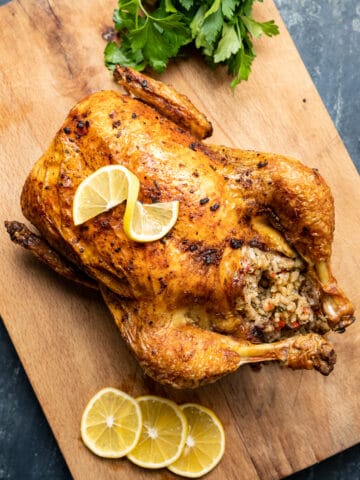
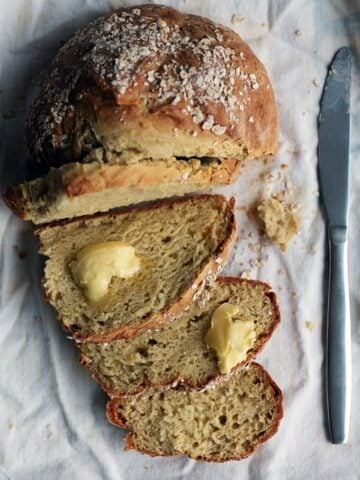
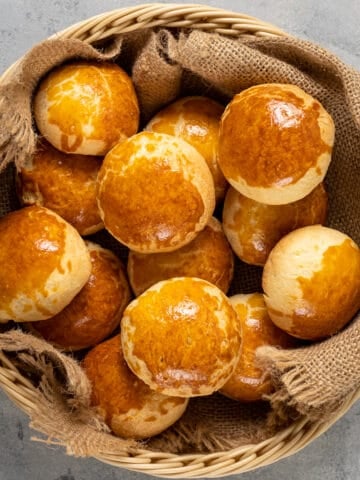

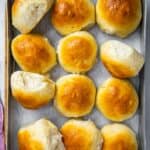
CYNTHIA CHIMBLO says
Thanks YUSUF, Made these for Thanksgiving yesterday. Big hit. I used 408 grams of Gold Medal Bread flour plus another 45gm for kneading. Baked up beautifully golden and tender on inside. It's a keeper.
Zerrin & Yusuf says
Hi Cynthia,
So happy to hear that you enjoyed these rolls for Thanksgiving! Thanks for sharing which flour you used, it will definitely be helpful for others.
Cheers!
Elaine says
This recipe is great! I reference it often when I want to make bread :). A tip if you're trying it yourself, I find 3.5 - 4 cups of flour works better than 3.
Zerrin & Yusuf says
Hi Elanie,
So happy to hear that you love this dinner roll recipe as much as we do. It is one of our go-to bread recipes.
Thanks for the tip! We always make these with the given measurements, but the type of flour might make a difference.
Cheers!
Carmen says
These look delicious. Can I freeze the dough? At what point do I freeze it?
Tracy Godfrey says
Omg these were so good... just starting trying to make my own breads etc and I will defiantly be using this recipe again. Thank you for a great recipe
Yusuf says
Hi Tracy,
So happy to hear that you loved these rolls. These are our favorite too, especially with butter and some cheese 🙂
Thanks for the feedback!
DeaMaree says
I have attempted these rolls twice. Both times the 3 cups flour was not enough for the dough to come together. Added flour until dough pulled away from sides of bowl (using stand mixer and dough hook). First time, it took almost a whole additional cup and the rolls were dense and crumbly. Second time I added less extra flour, but am afraid the extra flour and extra “knead” time will effect the texture again. Why will my dough not come together with the ingredients as lists?
Yusuf says
The dough should still be slightly sticky when all the ingredients are combined together. You might have to add a little extra flour, but a whole additional cup is definitely too much. What kind of flour are you using?
Mary Ann says
Hi my name is Mary Ann. Rolls made today for first time. I made in bread machine on dough cycle. Dough perfect.Rolls beautiful. My husband said these rolls taste like his beloved Mother’s rolls. I will make this recipe replacing many roll recipes that I have made in the past. Delicious, beautiful rolls and the rolls look like I bought from a Bakery. Thank you.
Yusuf says
Hi Mary Ann! So happy to hear that you and your husband loved the rolls! Thank you so much for your feedback!
Anne says
I made these rolls today and they turned out so good! I just added a little more sugar because I wanted it sweeter. Kids spread nutella in the center and I spread butter when they were still warm. YUM! Thank you for the recipe!